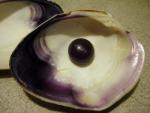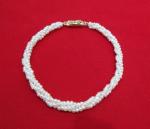Freshwater Pearls of North America - PDF Free Download 1984 Article

Natural USA River Pearl
Pearls are undoubtedly one of man's oldest treasures.
certain mollusks easy game. Inevitably, in time, he would
have encountered pearls within these mollusks. Only the
simplest of tools were needed to pierce these lustrous
objects and fashion them into enchanting, enduring ornaments. As civilization developed, the pearl was often
associated with purity, innocence, hope, and femininity.
In contemporary times, the pearl has come to be known
as the "Queen of Gems."
Historically, pearls have been enormously popular.
During the Renaissance, when exploration opened the
Orient and the New World to the traders of Europe, pearls
were sought with such passion that the period has been
called "the Pearl Age" (Kunz and Stephenson, 1908). No
opportunity was ignored, and so pearls were fished
wherever they could be found, from both freshwater and
saltwater sources.
The next great pearl boom occurred in the late 19th
and early 20th centuries, when pearl prices soared to
fabled heights not seen before or since. In fact, natural
pearls were so important during this period that many
fine jewelers derived most of their income, reportedly as
much as 80%, from the sale of pearls (Shire, 1982). Freshwater pearls played an important role in this market, because new discoveries of freshwater pearly mussels in the
lakes and rivers of the United States contributed significantly to the supply of fine
freshwater and other natural pearls have been overshadowed in recent years by the sheer volume of their
cultured counterparts, they continue to be one of the
classic gems, distinctive and highly prized for their
beauty, wearability, uniqueness, and rarity.
In this article, we will discuss the freshwater pearls of
North America, in particular those from the United
States (figure 1). We will review how the freshwater mussel and its pearls have been harvested and used, describe the natural history of these mussels and the pearls
they produce, and look at the future of the freshwater pearl industry-both natural and cultured in the United States.
A HISTORICAL PERSPECTIVE
There is good reason to believe that freshwater
pearls were found very early in man's history. Indigenous to the lakes and rivers of North
America, Europe, and Asia, the freshwater pearly
mussel was an easily accessible food source. Opportunistic aborigines had only to wade into the
shallows to be able to gather protein-rich food
from often enormous beds of Unio mussels. Even
in modern times, mussel beds have been found
stretching several miles along a river, harboring
hundreds of thousands of these creatures. Given
the tendency of these mussels to form pearls, it is
likely that men who lived off the mussels encountered freshwater pearls very early on.
Full 16 page PDF file may be downloaded at the following link.
SOURCE: https://www.gia.edu/gems-gemology/fall-1984-pearls-sweaney
Join in and write your own page! It's easy to do. How? Simply click here to return to Pearl News.











